Car seat compatible stroller: Top Benefits & Tips 2025
Simplifying Baby Travel: Finding the Perfect Car Seat Compatible Stroller
Car seat compatible strollers are strollers designed to securely attach to infant car seats, creating a seamless travel system for you and your baby. Here’s what you need to know:
- Look for manufacturer compatibility lists – Always check if your car seat brand works with your preferred stroller
- Adapters may be required – Some combinations need specific adapters for secure attachment
- Not all combinations work – Even strollers and car seats from the same brand might not be compatible
- Weight limits matter – Check both car seat and stroller weight restrictions before use
Finding the right combination of car seat and stroller shouldn’t feel like solving a complex puzzle. Yet for many new parents, the process can be overwhelming with hundreds of possible combinations and technical compatibility requirements to steer. The good news? With the right information, you can confidently select a travel system that perfectly suits your family’s needs.
When choosing a car seat compatible stroller, you’re essentially looking for a way to seamlessly transfer your sleeping baby from car to stroller without disturbing them. This convenience factor alone makes these travel systems worth the research time for busy parents.
I’m James Mark, a baby gear specialist with over 8 years of experience testing and reviewing car seat compatible stroller systems to help parents make informed decisions for their growing families. My work has involved evaluating hundreds of stroller and car seat combinations to identify the safest, most convenient options.
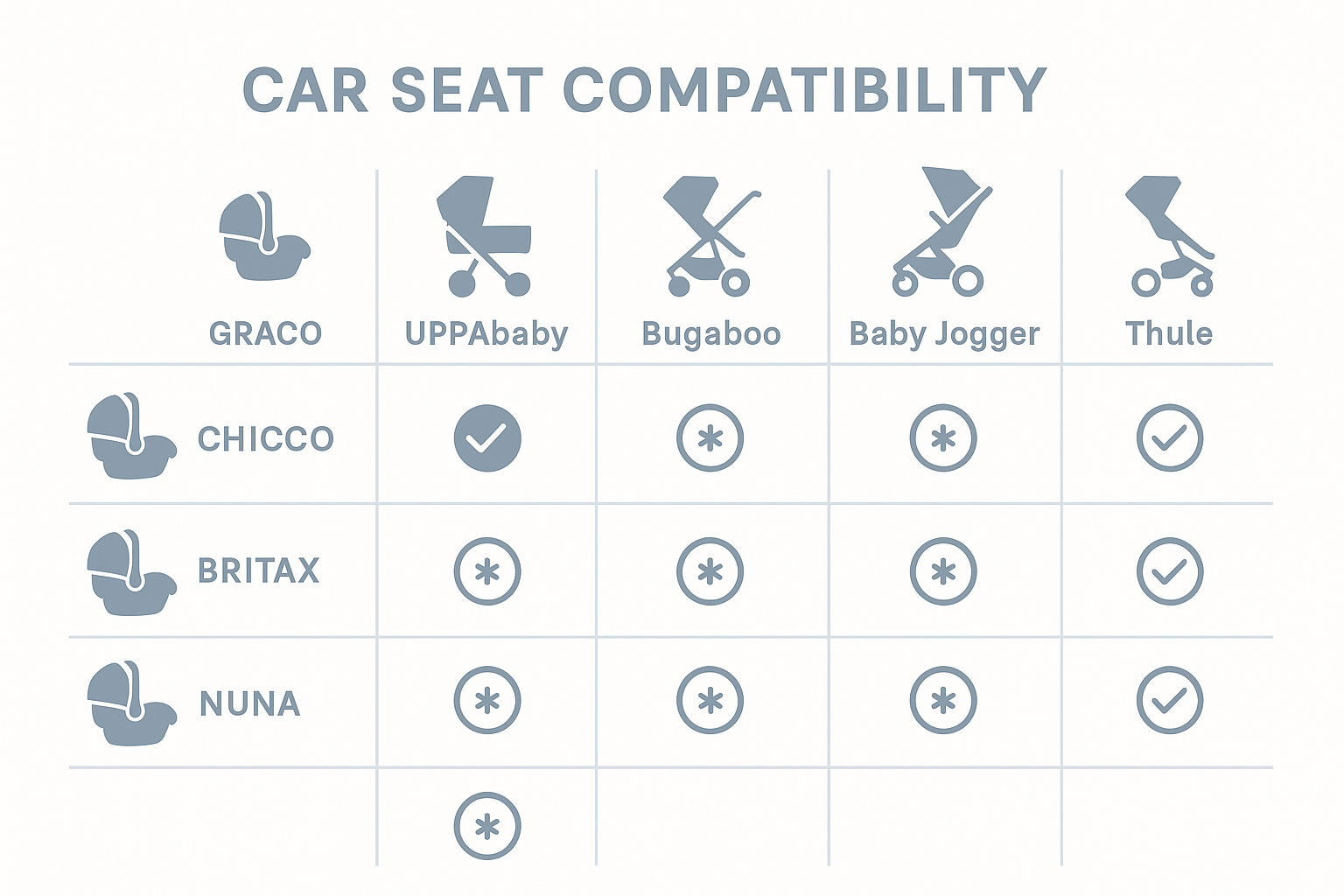
Essential Car seat compatible stroller terms:
The Benefits of Using a Car Seat Compatible Stroller
There’s a moment every parent knows all too well: you’ve just finished a car ride, your baby has finally drifted off to sleep, and now you need to transfer them to a stroller. It’s like trying to defuse a bomb—one wrong move and suddenly your peaceful outing turns into a crying marathon. This is exactly why car seat compatible strollers have become such a beloved essential for modern parents.
Seamless Transitions for Peace of Mind
The magic of a car seat compatible stroller lies in those precious, undisturbed transfers. When your little one falls asleep during a car ride (often the moment you pull into the parking lot), you can simply detach the car seat and click it onto your stroller frame without waking your sleeping angel.
One mom shared with us: “My daughter used to wake up screaming every time we reached our destination. Now with our travel system, she sleeps right through the transfer. It’s honestly changed our lives—we can actually go places again!”
Our customer surveys show this isn’t unusual—nearly 80% of parents rate “preserving baby’s sleep” as the number one benefit of their travel system. Those extra minutes or even hours of peace are absolutely priceless during the exhausting newborn phase.
Safety Without Compromise
When it comes to your baby, safety is never something to sacrifice for convenience. Thankfully, car seat compatible strollers deliver both. Your infant remains securely positioned in their properly fitted car seat, which is specifically engineered to support their delicate neck and developing spine.
This safety aspect is particularly crucial for newborns who don’t yet have the muscle control to sit upright. Instead of transferring them to a stroller seat that might not provide adequate support, they stay in the car seat that was designed precisely for their developmental stage.
One wheelchair-using parent, Katie, told us: “As someone with mobility challenges, this system has been a game-changer. I can manage the entire transfer independently, which gives me such freedom and confidence as a new mom.”
Time-Saving Convenience
Let’s be honest—with a newborn, time suddenly becomes your most precious commodity. Car seat compatible strollers eliminate the multi-step process of unbuckling, lifting, potentially soothing, and rebuckling your baby each time you transition from car to stroller.
This convenience multiplies when you have twins or multiple children. As one twin parent noted: “When you have two babies, you use your stroller so much more than singleton parents. Having a system where I can just click both car seats onto the frame has saved my sanity on countless occasions.”
Weather Protection
Those quick transfers also mean less exposure to challenging weather conditions. Whether it’s raining, snowing, or blazing hot outside, minimizing the time your baby spends exposed to the elements is a significant benefit that many parents don’t consider until they’re standing in a downpour trying to transfer a fussy baby.
Reduced Equipment Needs
New parenthood seems to come with an avalanche of baby gear. A car seat compatible stroller helps streamline your equipment needs by combining two essential items into one integrated system. Rather than purchasing separate specialized products for different scenarios, you invest in components that work together seamlessly.
This not only potentially saves money but also precious storage space in your home and vehicle. During those first months when your baby needs maximum head and neck support, you’ll have exactly what you need without unnecessary duplication.
For growing families on the go, the convenience, safety, and peace of mind that comes with a well-designed car seat compatible stroller is truly invaluable—turning what could be stressful transitions into smooth, peaceful moments for both you and your baby.
How to Determine if Your Car Seat is Compatible with a Specific Stroller
Let’s face it – with over 600 possible combinations of car seats and strollers on the market today, figuring out which ones work together can feel like trying to solve a particularly tricky puzzle. But don’t worry! Finding the right car seat compatible stroller doesn’t have to give you a headache. There are straightforward ways to check if your dream car seat and stroller will make a perfect match.
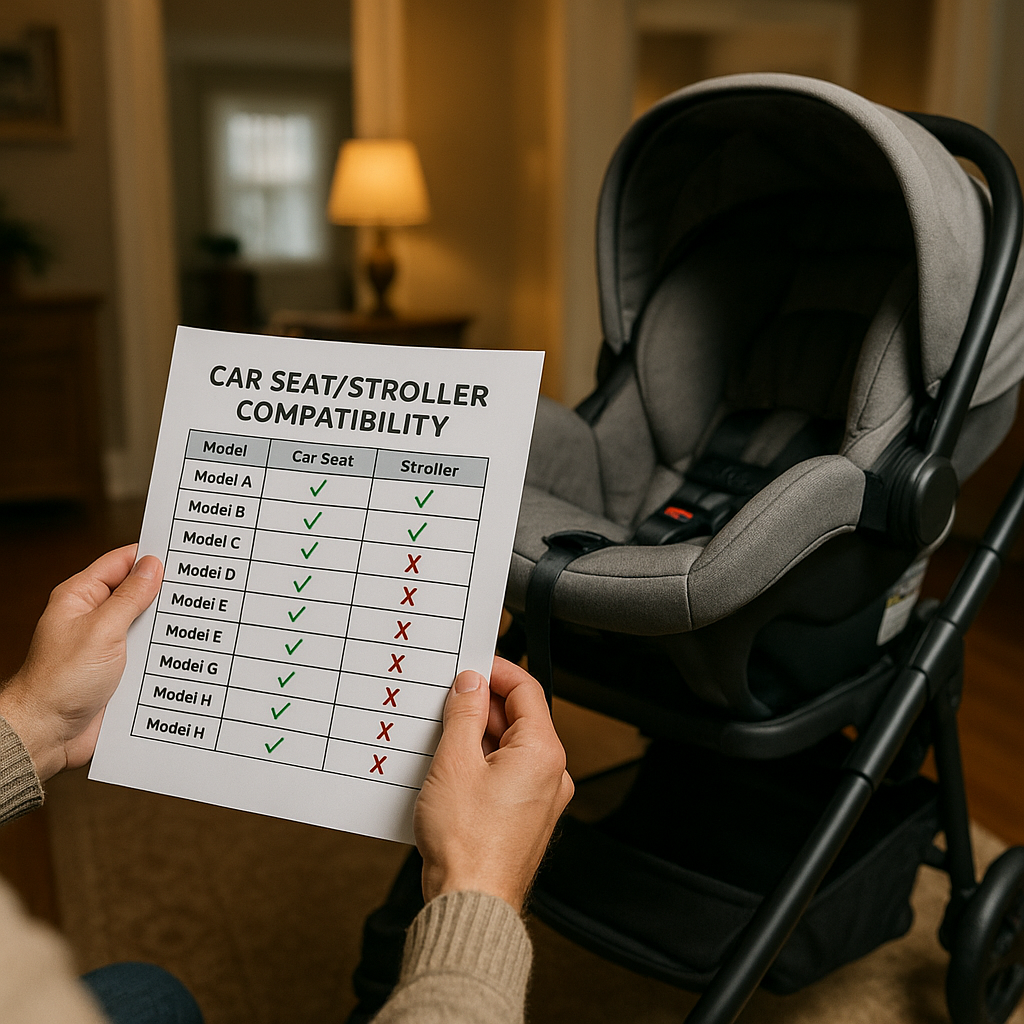
Check Manufacturer Guidelines First
Your most reliable compatibility detective? The manufacturers themselves. Most reputable brands provide detailed compatibility information that takes the guesswork out of the equation.
I recently helped a new mom who was completely overwhelmed by all the options. We visited Baby Jogger’s website together and finded they offer downloadable compatibility charts organized by region (US, Canada, Europe, Australia) and even manufacturing year. This was a game-changer for her!
It’s worth noting that compatibility can change between product generations – a 2018 model might not work with a 2022 model, even from the same brand. Always double-check the specific model and manufacturing year of both your car seat and stroller to avoid any surprises.
Look for Bundled Travel Systems
If you haven’t purchased either item yet, consider buying a bundled travel system. These packages include both a car seat and stroller that are guaranteed to work perfectly together. As one of our customers put it, “Getting my Graco travel system was the best decision I made – no adapter hunting, no compatibility worries, just click and go!”
Bundled systems not only eliminate compatibility concerns but often provide better value than buying components separately. It’s like getting a perfect puzzle where all the pieces already fit together.
Understand Adapter Requirements
Mixing brands or even different models within the same brand? You’ll likely need an adapter – that small but mighty device that ensures a secure connection between your car seat and stroller.
One thing that surprises many parents (and caught me off guard when I first started in this industry) is that not every car seat works with every stroller, even within the same brand! For example, an UPPAbaby MESA car seat might need a completely different adapter depending on whether you’re attaching it to an UPPAbaby CRUZ or VISTA stroller.
Think of adapters as translators – they help your car seat and stroller speak the same language and connect securely.
Use Compatibility Tools and Charts
Many retailers (including us at BabbyStrollers.com) offer comprehensive compatibility tools that take the detective work out of your hands. Simply input your car seat model, and these tools will show you which strollers will work with it, along with any required adapters.
Here’s a helpful tip when looking at those sometimes intimidating compatibility charts online: Use ctrl+F (Windows) or cmd+F (Mac) to search for your specific brand or model. This little keyboard shortcut can save you tons of time scrolling through extensive lists!
Ask for a Physical Demonstration
While online research is convenient, nothing beats seeing how things work in person. If possible, visit a baby gear store where staff can demonstrate how your chosen car seat attaches to a stroller.
I remember helping a couple who were convinced they needed a particular adapter based on online research. When they came into the store, we finded their car seat actually clicked directly into their stroller without any adapter at all! That hands-on experience saved them money and added convenience.
Understanding Car Seat Compatible Strollers
Car seat compatible strollers come in several varieties, each with unique benefits depending on your lifestyle needs.
Types of Car Seat Compatible Strollers
Full-size Strollers with Car Seat Compatibility offer the complete package – large storage baskets, adjustable handles, and all-terrain wheels – while accepting an infant car seat with the right adapter. The UPPAbaby Cruz v2 Combo consistently earns high marks from parents for how easily the car seat attaches and its overall functionality.
Lightweight Frame Strollers are minimalist heroes designed specifically for infant car seats. Weighing often less than 12 pounds (like the popular Chicco KeyFit Caddy at just 11.7 lbs), these affordable frames are perfect for parents who want something super portable during those early months.
Jogging Strollers with Car Seat Compatibility serve active parents well, though remember that actual jogging should wait until your baby is older (usually 6-8 months). These strollers feature better suspension and air-filled tires for smoother rides over varied terrain.
All-in-One Systems like the innovative Doona are truly unique – the car seat and stroller are the same product! One city-dwelling mom told me it was a “taxi game changer” for her family who rarely drove but frequently used rideshares.
Double Strollers with Car Seat Compatibility are lifesavers for parents of twins or closely-spaced siblings. Models like the Evenflo Pivot Xpand can accommodate two infant car seats simultaneously – a feature that twin parents consistently tell me is worth its weight in gold.
Car Seat Attachment Methods
Understanding how car seats attach to strollers matters for both convenience and safety:
Click-in Direct Attachment provides the most secure and user-friendly connection, where the car seat clicks directly into dedicated attachment points on the stroller. This method reduces the chance of installation errors and gives that satisfying “click” that tells you everything is secure.
Strap-in Attachment requires securing the car seat using straps. While effective when done correctly, this method requires more attention to detail and has more potential for user error. Always double-check that straps are tight and secure.
Adapter-Required Attachment is most common when mixing brands. The adapter serves as a bridge between your stroller and car seat. These adapters are designed for specific combinations of products, which is why universal adapters don’t always deliver the same level of security.
Dedicated vs. Universal Adapters
Dedicated adapters are designed by manufacturers for specific car seat and stroller combinations. They typically offer the most secure fit and easiest installation – like pieces made specifically for each other.
Universal adapters attempt to work with multiple car seat brands but may not provide the same level of security or ease of use as dedicated adapters. I always recommend approaching universal adapters with caution and only using them if the manufacturer confirms compatibility. When it comes to your baby’s safety, “probably compatible” isn’t good enough – you want to be certain.
Finding the right car seat compatible stroller might take a bit of research, but the convenience of seamlessly transferring your sleeping baby from car to stroller makes it absolutely worth the effort!
Universal Adapters: A Solution for Car Seat and Stroller Compatibility?
When you’re trying to make your car seat work with your stroller, you might come across “universal adapters” that promise to be the magic solution to all your compatibility woes. As a parent juggling a million things, the idea of one adapter that works with multiple car seats sounds like a dream come true. But do these universal options really deliver on their promises?
The Promise and Reality of Universal Adapters
I’ve tested dozens of these adapters with parents just like you, and the truth is a bit more complicated than the marketing suggests. Universal car seat adapters are designed with adjustable components that can be configured to fit various car seat shapes and attachment points. They’re meant to be the Swiss Army knife of baby gear connections.
However, there’s an important reality check needed here. Safety concerns should be your first consideration with universal adapters. Unlike dedicated adapters made specifically for your exact car seat and stroller combination, universal options might not provide that precise, rock-solid fit that gives you complete peace of mind when your precious cargo is onboard.
Despite having “universal” in the name, most of these adapters still have significant compatibility limitations. I’ve seen many disappointed parents find that their “universal” adapter doesn’t work with their particular combination after all. Always, and I mean always, check the manufacturer’s specific compatibility list before purchasing.
The installation process for universal adapters tends to be more involved too. With more adjustable parts comes more complexity, which unfortunately increases the chances of incorrect installation. When you’re sleep-deprived and trying to get out the door with a fussy baby, the last thing you need is a complicated adapter setup.
Something many parents don’t consider is how using non-recommended adapters might affect their warranty coverage. Many manufacturers explicitly state that using unauthorized adapters can void warranties on both your car seat and stroller. That $30 universal adapter suddenly doesn’t seem like such a bargain if it puts your $300 stroller warranty at risk.
Research from SafeRide4Kids emphasizes that proper attachment mechanisms are crucial for maintaining the safety benefits of your car seat when used with a stroller.
When Universal Adapters Make Sense
That said, I don’t want to dismiss universal adapters entirely. There are legitimate situations where they can be a practical solution:
If you’re traveling with a rental stroller, a universal adapter might be your best option for a short-term fix. They’re also handy as a backup solution when your dedicated adapter is misplaced (we’ve all been there!). For occasional use with grandparents or babysitters who might have different strollers, a universal adapter can make sense too.
The key is to only use universal adapters when they’re specifically approved by both your car seat and stroller manufacturers. Some companies do test their products with certain universal adapters and give them their stamp of approval.
Expert Recommendation
Based on years of working with parents and safety experts, my recommendation aligns with what pediatricians and child passenger safety technicians suggest: whenever possible, use the dedicated adapter recommended by your car seat and stroller manufacturers.
As Dr. Juliet Spurrier, a pediatrician who reviews baby gear, notes: “Click-in-only attachments are recommended because they reduce potential errors compared to systems requiring additional straps, ensuring a safer and simpler installation process.”
Yes, dedicated adapters might mean spending a bit more money, especially if you switch strollers or car seats. But when it comes to your baby’s safety, that extra $20-30 provides valuable peace of mind knowing that your car seat compatible stroller system is being used exactly as designed by the engineers who created it.
The convenience of a universal adapter is appealing, but it should never come at the expense of your child’s safety. When in doubt, go with what the manufacturers specifically recommend for your gear.
Safety Considerations When Using a Car Seat with a Stroller
When it comes to your precious little one, safety isn’t just a priority—it’s everything. Using a car seat compatible stroller properly requires attention to detail and an understanding of key safety principles that protect your baby during transitions and outings.
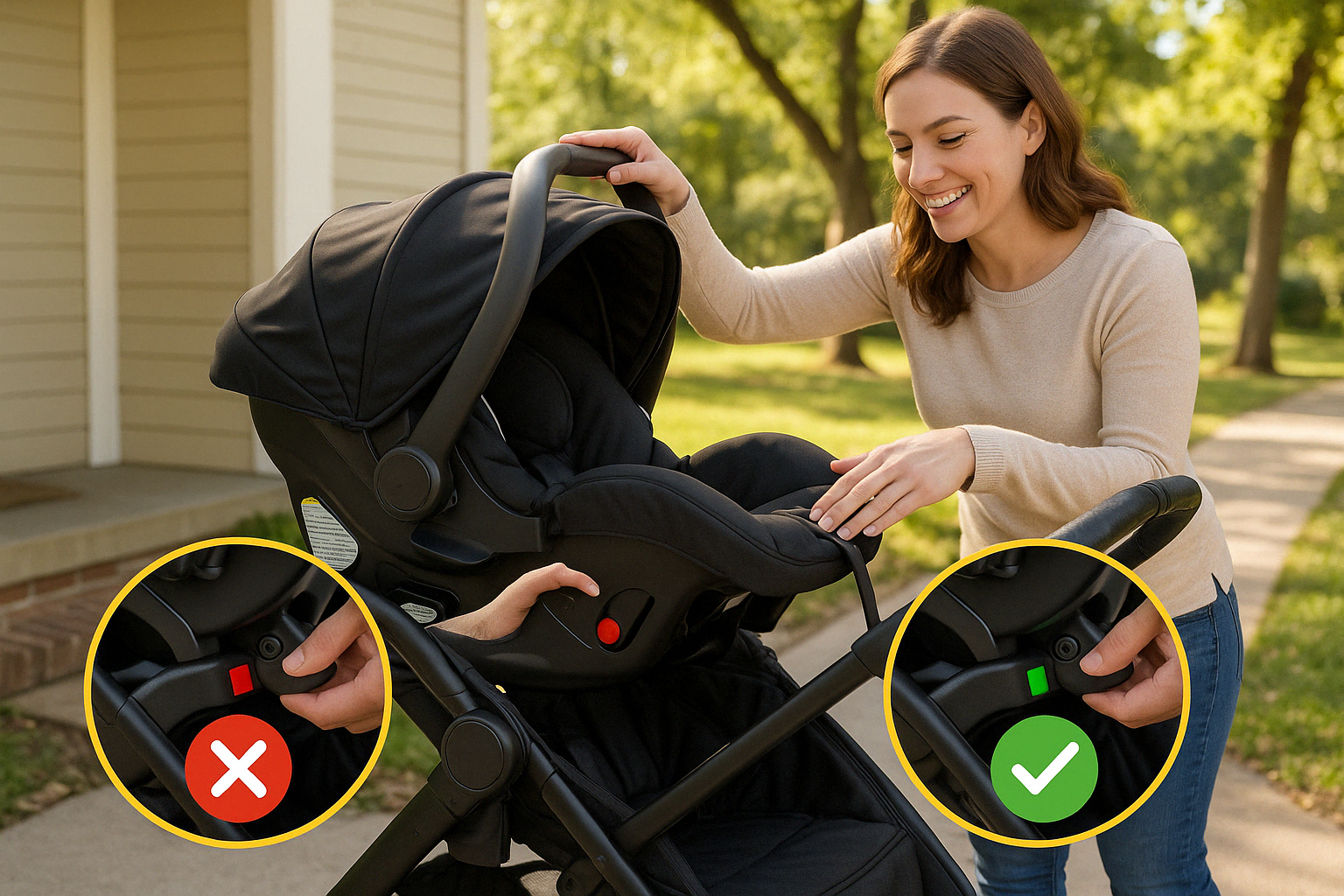
Proper Installation is Non-Negotiable
That satisfying “click” when your car seat locks into place isn’t just a convenient sound—it’s your baby’s safety system confirming all is well. Proper installation is absolutely essential when using a car seat compatible stroller.
First and foremost, always follow the manufacturer’s instructions to the letter. Each combination of car seat and stroller has its own specific requirements, and those tiny details matter enormously. After attaching your car seat, give it a firm tug to confirm it’s truly secure—it should feel rock-solid with no wiggling, shifting, or rocking when pushed from any direction.
Many modern systems include intuitive indicator systems—listen for that reassuring click or look for visual indicators (often colored green) that confirm proper installation. These small features provide big peace of mind for sleep-deprived parents juggling multiple tasks.
As one mom told us, “I always give my daughter’s car seat a good tug after I click it in. That little test has become second nature, like checking that I have my keys before leaving the house.”
Time Limitations Outside the Vehicle
Here’s something many new parents don’t realize: infant car seats are engineered primarily for vehicle safety, not as all-day seating devices. Safety guidelines recommend that babies shouldn’t remain in a car seat for more than two hours at a time when used outside of a vehicle.
Why? The semi-reclined position, while perfect for car safety, can potentially restrict airflow if used for extended periods. This is especially important for newborns whose neck muscles are still developing. For longer outings, consider strollers with bassinet attachments that allow your baby to lie flat.
“The ideal is to use bassinets for longer outings,” notes pediatric safety expert Dr. Hannah Morris, “but for quick errands, keeping babies in the car seat is perfectly acceptable. Just be mindful of the clock.”
Weight and Height Limits
Both your car seat and stroller have specific weight and height limitations—and exceeding these isn’t just breaking the rules, it’s compromising your baby’s safety. Most infant car seats accommodate babies from 4-35 pounds and up to 30-32 inches tall, but always check your specific model’s limits.
Stroller frames have their own weight restrictions that include both the car seat and your growing baby. Even adapters may have separate weight guidelines. As your little one approaches these limits, it’s time to transition to the next appropriate solution rather than pushing the boundaries.
Stability Considerations
Adding a car seat to your stroller raises its center of gravity, making stability an important consideration. Think of it like carrying a backpack up high instead of down low—it changes how the whole system balances.
Always engage the stroller’s brakes when you stop, even for a moment. Hang diaper bags and purses on designated hooks rather than draping them over the handlebar, which can cause tipping. Be particularly cautious when navigating curbs, ramps, or uneven terrain, and never—even for a quick moment—leave your baby unattended in the stroller.
Ensuring Safety with Your Car Seat Compatible Stroller
Beyond these basics, there are several practices that can improve your car seat compatible stroller safety routine.
Follow All Instructions Carefully
Those instruction manuals might not be thrilling bedtime reading, but they contain vital safety information. Manufacturers conduct extensive testing based on their specified usage guidelines, so reading and following the manuals for your car seat, stroller, and any adapters is crucial for your baby’s safety.
“I keep digital copies of all my baby gear manuals on my phone,” shares one tech-savvy dad. “That way I can quickly reference them if I’m ever unsure about something when we’re out and about.”
Perform Regular Safety Checks
Make quick safety checks part of your routine before each outing. Verify that the adapter is securely attached to the stroller, the car seat is properly locked onto the adapter, all stroller locks and latches are engaged, and the harness system is correctly adjusted for your baby’s size.
These quick checks become second nature after a while—like checking your mirrors before driving. One parent shared, “I do a three-point check every time: adapter secure, car seat clicked, harness snug. It takes five seconds but gives me complete confidence.”
Avoid Common Mistakes
Even experienced parents can make mistakes with car seat compatible strollers. Common errors include using unauthorized adapters not approved by both manufacturers, adding aftermarket padding or accessories to the car seat, hanging heavy bags on the stroller handlebar, or using the stroller for activities it wasn’t designed for—like jogging on a standard stroller.
Each of these seemingly small decisions can significantly impact your stroller’s safety performance. Stick with manufacturer-approved accessories and use your gear as intended.
Practice Makes Perfect
Many parents admit feeling nervous the first few times they attach and detach the car seat from their stroller. This is completely normal! Practice the process at home several times before heading out with your baby. Try it in different lighting conditions and spaces similar to where you’ll be using it—like your garage, driveway, or a cramped cafe simulation.
As you gain confidence, the process will become smoother, reducing stress during transitions when you’re also managing a baby, diaper bag, and possibly other children too.
The extra minute you spend ensuring your car seat compatible stroller is properly set up could be the most important minute of your day. After all, nothing is more precious than the cargo you’re carrying.
Car Seat Compatible Stroller vs Traditional Travel System: What’s the Difference?
When you’re shopping for baby gear, the terminology can quickly become overwhelming. Many parents find themselves wondering about the difference between a car seat compatible stroller and a traditional travel system. Let’s clear up this confusion so you can make the best choice for your family.
Definitions and Key Differences
A car seat compatible stroller is any stroller designed to work with an infant car seat, whether directly or with an adapter. These versatile options come in many styles—from lightweight frames to full-featured joggers—that can accommodate your infant car seat with the right connections.
In contrast, a traditional travel system is a bundled package that includes both a stroller and an infant car seat from the same manufacturer, specifically designed to work together without any additional pieces.
Here’s how they stack up against each other:
| Feature | Car Seat Compatible Stroller | Traditional Travel System |
|---|---|---|
| Components | Stroller + separate car seat + potential adapter | Bundled stroller and car seat package |
| Brand mixing | Allows mixing brands with appropriate adapters | Typically same-brand components |
| Initial cost | Can be higher if purchased separately | Often more economical as a bundle |
| Customization | Greater flexibility to choose preferred car seat and stroller | Limited to the bundled components |
| Ease of use | May require adapter installation | Designed for seamless integration |
| Long-term value | Can select components that best meet specific needs | May compromise on individual component preferences |
Functionality Comparison
When it comes to ease of use, traditional travel systems shine because everything works together right out of the box. There’s something reassuring about knowing your gear was designed as a matched set. As one mom told us, “I loved how everything just clicked together perfectly—no guesswork involved.”
On the other hand, car seat compatible strollers offer you the freedom to mix and match based on your specific needs. Maybe you’ve fallen in love with a particular car seat known for its exceptional safety ratings, but you also want a compact stroller that fits easily in your small car trunk. With compatible systems, you can have both!
“I wanted the safety features of a Nuna car seat but needed the all-terrain capabilities of a BOB stroller for our rural home,” explains Sarah, a first-time mom. “With an adapter, I got the best of both worlds.”
Pros and Cons of Each Approach
Traditional travel systems have the advantage of simplicity. Everything works together seamlessly, and you’ll often save money compared to buying pieces separately. Plus, there’s the confidence of knowing the components were designed to complement each other perfectly.
The downside? You might have to compromise on features. Perhaps you love the car seat but find the stroller bulky, or vice versa.
With a car seat compatible stroller approach, you get to cherry-pick exactly what you want. The car seat that topped safety ratings? The stroller that folds with one hand? You can have both! The potential drawbacks include higher costs (especially when adapters are needed) and occasionally less seamless connections between components.
Cost Considerations
While traditional travel systems typically offer upfront savings, the long-term value depends on your family’s specific needs:
Traditional travel systems might cost less initially but could require replacement sooner if individual components don’t meet your evolving needs as your baby grows.
Car seat compatible strollers might require a higher initial investment (especially when you factor in adapters) but could provide better long-term value if chosen to perfectly align with your lifestyle and needs.
As Rachel, a BabbyStrollers.com customer, shared: “Another masterpiece! Sleek, stylish, sporty and sophisticated are all words that come to mind but functional is always in 1st place.”
Real-World Perspective
Many experienced parents find that a hybrid approach works best. For example, some start with a simple frame stroller that works with their carefully chosen infant car seat. This lightweight option is perfect for those early months when you’re transferring a sleeping newborn between car and stroller.
Later, as their baby grows and their needs change, they invest in a full-featured stroller with all the bells and whistles that make toddler outings more manageable. The infant car seat continues to serve its purpose in the car until the baby outgrows it.
This flexible approach gives you the best features for each stage of your baby’s development while maximizing the value of each piece of gear you buy.
What’s right for your family? Consider your lifestyle, budget, and the specific features that matter most to you. Whether you choose a traditional travel system or a car seat compatible stroller with adapters, the perfect solution is the one that makes your daily life with baby smoother and more enjoyable.
Best Practices for Using a Car Seat Compatible Stroller
After helping thousands of parents steer car seat compatible strollers, we’ve gathered these practical tips to help you get the most out of your travel system while keeping safety and convenience at the forefront.
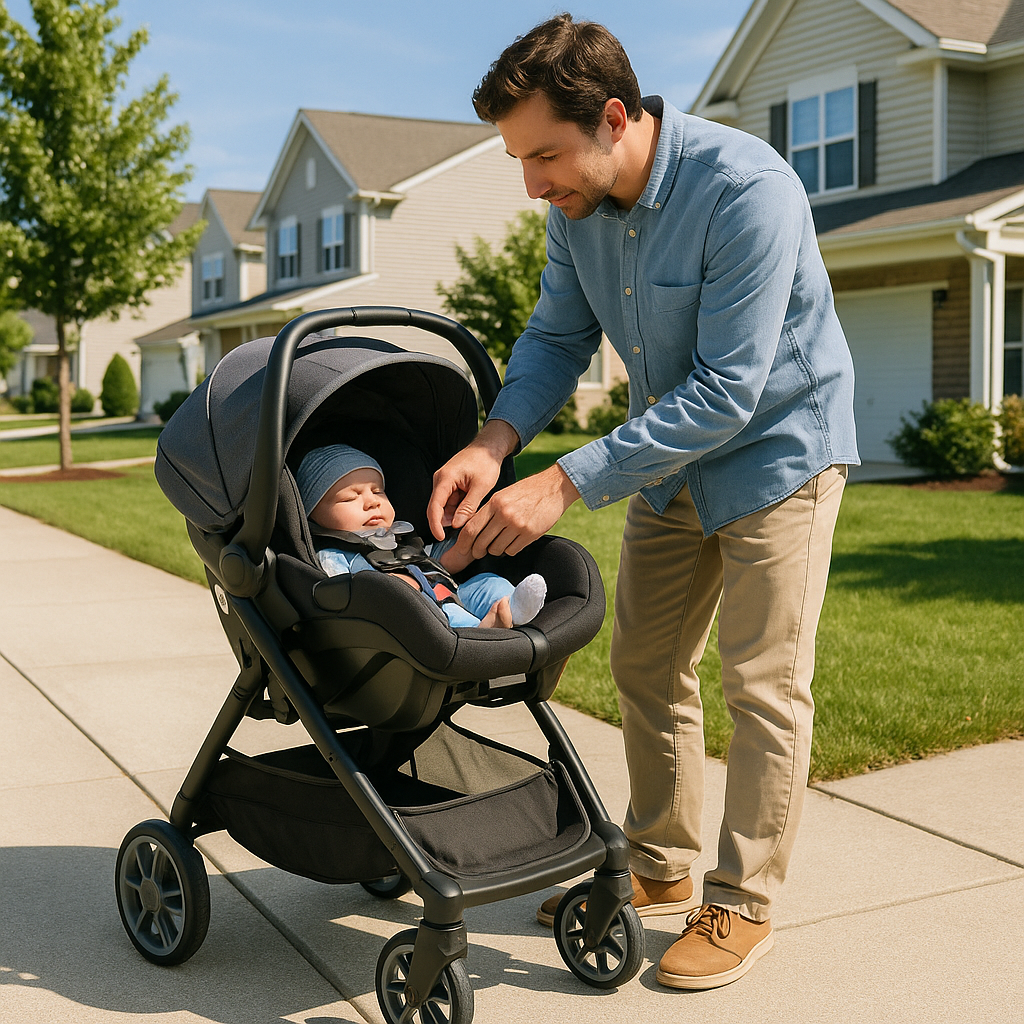
Installation and Usage Best Practices
That satisfying “click” when your car seat locks into place isn’t just a pleasant sound—it’s your baby’s safety system working perfectly. Always use both hands when attaching or removing the car seat from your stroller. This two-handed approach gives you better control and ensures proper alignment, reducing the risk of a wobbly or insecure connection.
Most car seats should face you when attached to the stroller. This parent-facing position not only lets you keep an eye on your little one but also provides better protection from sun, wind, and other elements. It’s also the perfect position for those adorable mid-stroll conversations with your wide-eyed passenger!
Before you start rolling, give the car seat a gentle but firm tug to verify it’s securely attached. This quick safety check becomes second nature after a few outings and provides invaluable peace of mind. And remember to maintain the proper recline angle recommended by your car seat manufacturer—this is especially crucial for newborns whose neck muscles are still developing.
Comfort Considerations
Your baby’s comfort directly impacts your outing success! Always use weather protection designed specifically for your car seat compatible stroller. Those improvised covers might seem clever, but they can restrict airflow and create unsafe conditions.
One rule many new parents don’t know: babies shouldn’t remain in car seats for extended periods. For longer trips, consider a stroller with a bassinet attachment or fully-reclining seat. This gives your baby a chance to stretch out and change positions, which is better for their developing body.
When it comes to dressing your little one, avoid bulky clothing inside the car seat harness. Instead, secure your baby properly with the harness against their body, then add blankets over the top if needed. And always check the temperature of the car seat surface before placing your baby inside—car seats can heat up quickly in the sun or feel chilly after sitting in a cold car.
“My daughter falls asleep almost instantly in her car seat, and thanks to our car seat compatible stroller, I can transfer her without waking her up,” shares Morgan, a mom of two. “But I always set a timer to remind me when it’s time to move her to a flat surface for longer naps.”
Maintenance Tips
Your travel system is an investment worth protecting! Regular cleaning according to manufacturer guidelines keeps everything functioning smoothly. Pay special attention to those adapter connection points—they’re easy to overlook but crucial to safety.
Make a habit of inspecting connection points, locking mechanisms, and adapters for signs of wear and tear. If you spot any damage, replace those components immediately rather than taking chances. When not in use, store adapters in a designated place (many strollers have hidden pockets designed specifically for this).
Weather can be surprisingly hard on stroller components. Avoid leaving your stroller with adapters attached in extreme heat, cold, or damp conditions, as this can cause materials to degrade over time. A quick wipe-down after outings in light rain or snow can prevent corrosion of metal parts.
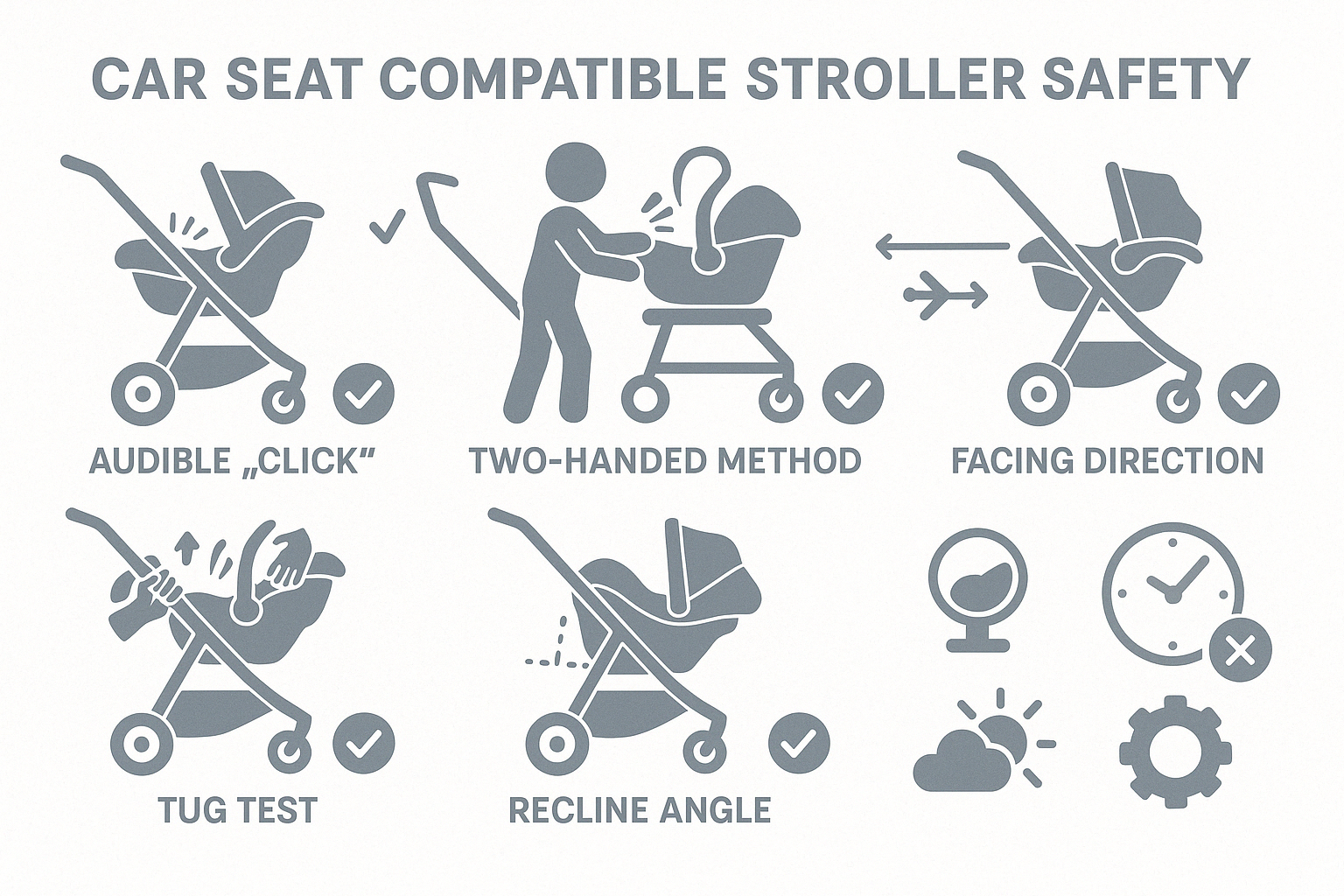
Travel and Transport Tips
Before heading out on a trip with your car seat compatible stroller, practice folding it with and without the adapter attached. Some strollers can fold with adapters in place, while others require removal first—knowing yours saves frustration when you’re trying to quickly pack up with a fussy baby!
When flying, consider a protective bag for your stroller to prevent damage during handling. If you’re gate-checking your stroller, remove the adapters and pack them in your carry-on. Those small but crucial pieces can easily get lost in transit, leaving you with an incompatible system at your destination.
Perfect your car-to-stroller transition routine. Having a consistent process makes moves smoother—whether that’s parking near cart returns for a flat surface, opening the stroller before removing the car seat, or having a designated spot for your keys and phone during transfers.
As Lexi, one delighted parent, told us: “Best parenting invention. I can’t stress enough how convenient this invention is! It’s worth every single penny! We purchased the midnight black edition. It rides so smooth.”
With these practical tips, you’ll be strolling confidently with your car seat compatible stroller in no time, enjoying the freedom and convenience these ingenious systems provide while keeping your precious cargo safe and comfortable.
Frequently Asked Questions about Car Seat Compatible Strollers
Can I use any car seat with any stroller?
If only baby gear were that simple! No, not all car seats are compatible with all strollers – and this misunderstanding catches many new parents by surprise.
Think of car seats and strollers like puzzle pieces – they need to fit together properly to create a safe travel system for your little one. Some brands play nicely together, while others simply won’t connect no matter how hard you try.
Brand compatibility is your first consideration. Some strollers only work with car seats from the same manufacturer (like the Chicco KeyFit with Chicco strollers), while others are more flexible. I remember helping a frustrated mom who couldn’t understand why her Graco car seat wouldn’t click into her UPPAbaby stroller – she hadn’t realized she needed a specific adapter to bridge these different brands.
Speaking of adapters, these little devices are often the magic that makes cross-brand compatibility possible. They’re designed for specific pairings, though – not as universal solutions. Think of them as specialized translators helping your car seat and stroller communicate properly.
Even within the same brand family, model-specific compatibility matters enormously. Just because you have a Britax car seat and Britax stroller doesn’t guarantee they’ll work together. I’ve seen the disappointment on parents’ faces when they find this the hard way!
Don’t forget to check the manufacturing year too. Newer models might not work with older adapters or vice versa. As one baby gear expert wisely noted: “There is no universal Car Seat + Stroller matchmaking website; compatibility must be checked per manufacturer.” Always do your homework before purchasing!
How do car seat compatible strollers accommodate growing infants and toddlers?
One of the beautiful things about investing in a quality car seat compatible stroller is how it can grow alongside your little one from those first precious newborn days through the toddler years.
During the infant car seat phase (roughly 0-12 months), your stroller essentially serves as a wheeled frame for your infant car seat. This setup is perfect for newborns who can’t yet sit unassisted and need proper head and neck support. The seamless transfers between car and stroller during this phase are truly a sanity-saver – especially when you’ve finally gotten your little one to sleep!
As your baby develops better neck control and starts sitting up (typically around 9-18 months), you enter what I call the transition phase. This is where many stroller systems really shine, offering reclining seats with multiple positions to accommodate your growing baby. Some models even include a bassinet attachment for this in-between stage, giving your baby a perfectly flat surface for healthier development during longer outings.
By the toddler phase (18+ months), your curious little explorer can fully enjoy the stroller in its standard upright configuration. Features like adjustable footrests accommodate those growing legs, while higher weight limits ensure you’ll get plenty of use as your child continues to grow.
The UPPAbaby Cruz v2 Combo exemplifies this adaptability perfectly. As one satisfied parent shared: “It’s a high-quality stroller that can be used from birth through the toddler years, making it a great value for parents looking for a long-term solution.” That kind of longevity makes the initial investment much easier to justify!
How do I choose the best car seat compatible stroller?
Finding your perfect car seat compatible stroller match is a bit like dating – it’s all about finding the right fit for your specific lifestyle and needs.
Start by thinking about your environment. Are you navigating narrow city sidewalks and public transit? A compact, lightweight stroller with easy folding might be your perfect match. Suburban parents might prioritize generous storage baskets and trunk-friendly folding. If you’re hitting trails or uneven terrain regularly, those all-terrain wheels and robust suspension will be worth their weight in gold.
Your daily routine should heavily influence your decision too. I remember helping a mom who took the subway daily choose a lightweight system she could manage on stairs when elevators were out of service. Meanwhile, a family who drove everywhere prioritized a travel system with the smoothest car-to-stroller transitions. Think realistically about how you’ll use this stroller most days.
Don’t forget to evaluate the long-term value. Will this stroller grow with your family? Could it accommodate a second child down the road? The most economical choice isn’t always the cheapest initial purchase – sometimes spending more upfront saves money over time.
Practical features matter tremendously in day-to-day use. That perfectly stylish stroller won’t feel so perfect if it doesn’t fit in your trunk or weighs too much to carry up your porch steps. Measure your storage spaces, test the weight, and really consider how much storage you typically need for outings.
One twin parent shared this perspective that really stuck with me: “Imagine: you get to your destination. Both babies are sleeping in their car seats. You’d love for them to continue sleeping during this errand or while you have lunch.” This scenario beautifully illustrates why ease of transfer between car and stroller can be such a crucial feature!
How do I ensure safety when using a car seat compatible stroller?
Safety should always be your top priority when using a car seat compatible stroller. The good news is that with proper use, these travel systems offer a secure way to transport your precious cargo.
Proper installation is absolutely critical. Always follow the exact instructions for your specific car seat, stroller, and adapter combination. Listen for that reassuring “click” that confirms secure attachment, and give the car seat a gentle tug to verify it’s locked in place before moving. I always recommend practicing at home several times before heading out with your baby – those first few attachments can feel awkward until you get the hang of it.
Time limitations matter too. Car seats are designed primarily for travel safety, not as all-day seating devices. Experts recommend limiting car seat time to two hours or less when outside the vehicle. For longer outings, consider transitioning to a stroller bassinet or fully-reclined seat position that allows your baby to lie flat.
Regular safety checks should become part of your routine. Inspect connection points, adapters, and locking mechanisms for any signs of wear or damage. Keep adapter connections clean and free of debris that could interfere with secure attachment. And always engage the stroller brakes when stopped, even on surfaces that seem perfectly level.
As your baby grows, stay mindful of weight limits for both your car seat and stroller. Exceeding these limits compromises safety and stability. When your child outgrows the infant car seat, it’s time to transition to using the stroller seat directly.
With proper attention to these safety considerations, your car seat compatible stroller can provide years of safe, convenient transportation for your growing child.
Conclusion
Finding the perfect car seat compatible stroller feels a bit like solving a puzzle at first, but it doesn’t have to be overwhelming. Throughout this guide, we’ve walked through everything you need to know to make this important decision with confidence.
When it comes down to it, your stroller system needs to work for your real life – not just look good in photos. The right combination will make those daily transitions between car and stroller smooth and stress-free, letting you focus on what really matters: enjoying time with your little one.
Remember these key points as you make your decision:
Safety is non-negotiable. Always verify compatibility through manufacturer guidelines and never use adapters that aren’t specifically approved for your car seat and stroller combination. Those few extra minutes of research can make all the difference in keeping your baby secure.
Your lifestyle should guide your choice. Are you navigating busy city sidewalks? Hiking on weekends? Frequently traveling by car? The best stroller for a downtown apartment dweller might be completely different from what works for a suburban family with a large SUV.
Think beyond the newborn phase. Those early months fly by faster than you might expect! The most practical car seat compatible strollers adapt as your baby grows from infant to curious toddler, potentially saving you from purchasing multiple strollers as needs change.
Practice makes perfect. There’s nothing quite like standing in a parking lot with a crying baby and luggage while trying to figure out how to attach your car seat to your stroller for the first time. Take time to master the attachment process at home before venturing out.
Respect the limits. Follow guidelines on how long babies should remain in car seats (generally no more than two hours), and always adhere to weight and height restrictions. Your baby’s comfort and safety depend on it.
At BabbyStrollers.com, we understand that becoming a parent comes with enough challenges – finding the right gear shouldn’t be one of them. Our team is passionate about helping families find travel solutions that make life easier, not more complicated.
Whether you’re expecting your first baby or looking to upgrade your current setup, we invite you to browse our thoughtfully curated selection of car seat compatible strollers. Our detailed compatibility guides take the guesswork out of creating your perfect travel system.
For more information about choosing the right stroller for your family’s unique needs, visit our detailed buying guide. Our baby gear specialists are always ready to answer your questions and provide personalized recommendations based on what matters most to you.
After all, your parenting journey should be focused on making memories with your little one—not struggling with complicated baby gear. Let us help you find the perfect travel solution so you can focus on the joys of parenthood, one smooth transition at a time.


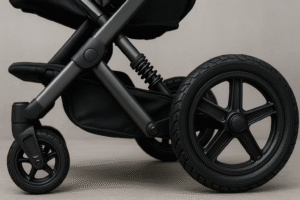
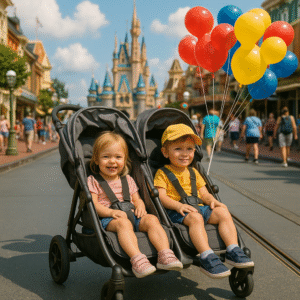
Pingback: Stroller Compatible with Safety 1st Car Seat: Top 3 Picks 2025